Text Mining and Sentiment Analysis of Online Restaurant Reviews
VerifiedAdded on 2022/09/18
|29
|15405
|52
Report
AI Summary
This study investigates the structure of online restaurant reviews and the influence of various attributes and sentiments on restaurant star ratings. The research proposes context as a fifth attribute, alongside food, service, ambiance, and price, which are commonly identified in past research. Through sentiment analysis of online reviews, the study confirms the proposed structure and demonstrates that consumer sentiments regarding these five attributes significantly explain the variance in star ratings. The findings reveal that food, service, and context are the top three attributes affecting star ratings, followed by price and ambiance. The study addresses two key gaps in existing research: the identification of structured information from free-form text and the understanding of how these attributes influence overall consumer evaluations. The methodology combines textual content and metadata from online reviews to provide empirical answers to research questions regarding consumer perceptions of dining experiences and the impact of attributes on overall restaurant ratings.
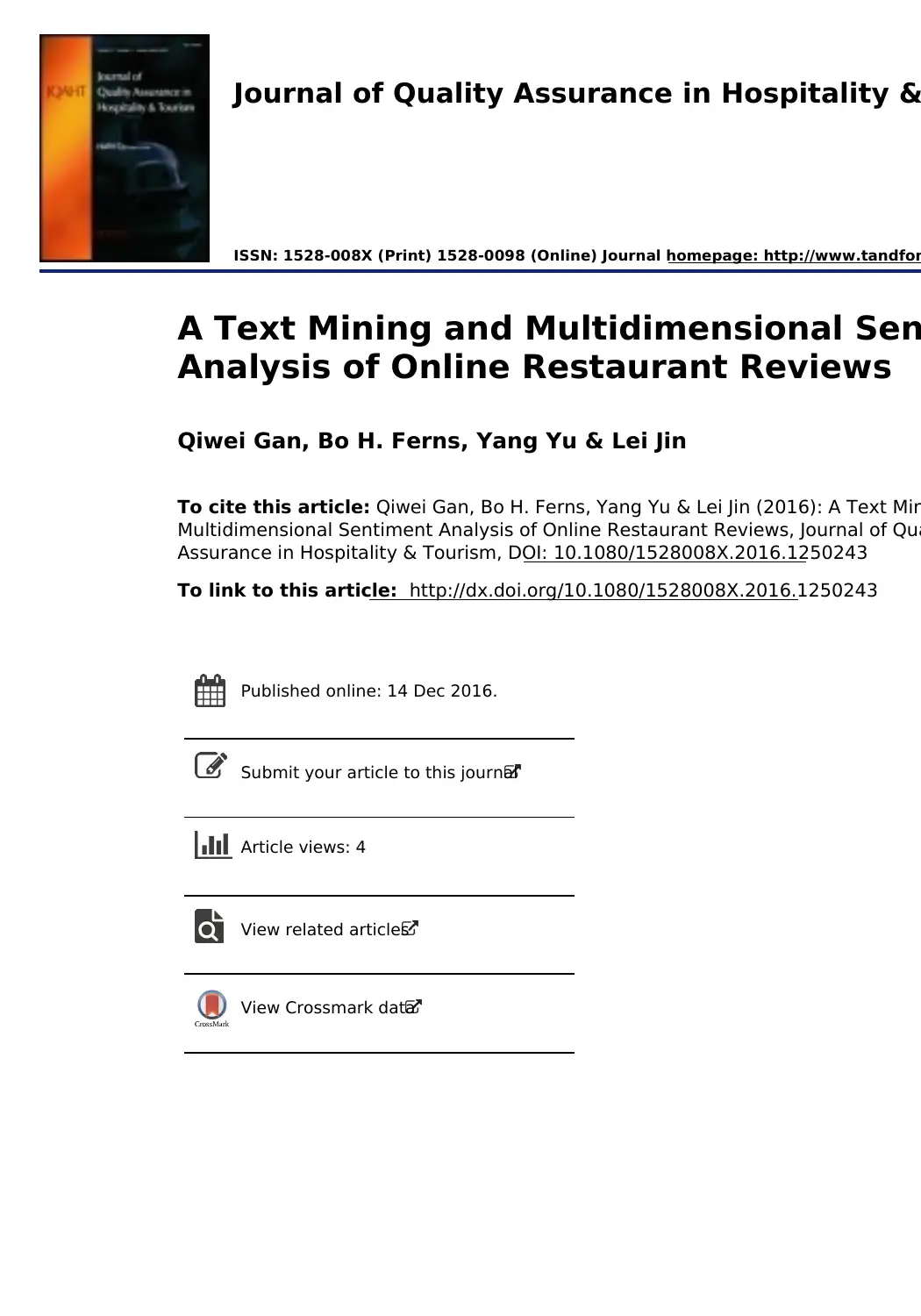
Journal of Quality Assurance in Hospitality &
ISSN: 1528-008X (Print) 1528-0098 (Online) Journal homepage: http://www.tandfon
A Text Mining and Multidimensional Sen
Analysis of Online Restaurant Reviews
Qiwei Gan, Bo H. Ferns, Yang Yu & Lei Jin
To cite this article: Qiwei Gan, Bo H. Ferns, Yang Yu & Lei Jin (2016): A Text Min
Multidimensional Sentiment Analysis of Online Restaurant Reviews, Journal of Qua
Assurance in Hospitality & Tourism, DOI: 10.1080/1528008X.2016.1250243
To link to this article: http://dx.doi.org/10.1080/1528008X.2016.1250243
Published online: 14 Dec 2016.
Submit your article to this journal
Article views: 4
View related articles
View Crossmark data
ISSN: 1528-008X (Print) 1528-0098 (Online) Journal homepage: http://www.tandfon
A Text Mining and Multidimensional Sen
Analysis of Online Restaurant Reviews
Qiwei Gan, Bo H. Ferns, Yang Yu & Lei Jin
To cite this article: Qiwei Gan, Bo H. Ferns, Yang Yu & Lei Jin (2016): A Text Min
Multidimensional Sentiment Analysis of Online Restaurant Reviews, Journal of Qua
Assurance in Hospitality & Tourism, DOI: 10.1080/1528008X.2016.1250243
To link to this article: http://dx.doi.org/10.1080/1528008X.2016.1250243
Published online: 14 Dec 2016.
Submit your article to this journal
Article views: 4
View related articles
View Crossmark data
Paraphrase This Document
Need a fresh take? Get an instant paraphrase of this document with our AI Paraphraser
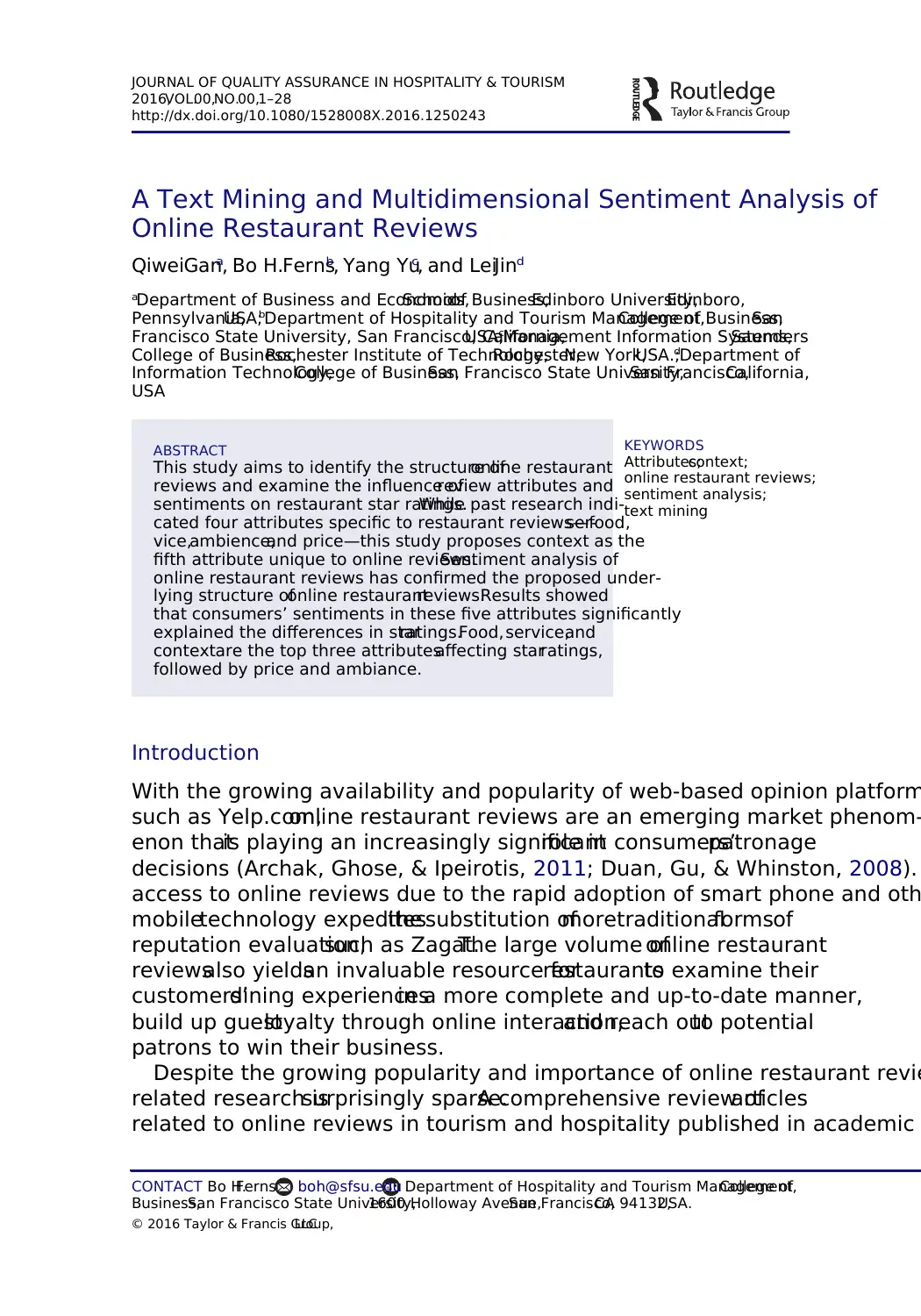
A Text Mining and Multidimensional Sentiment Analysis of
Online Restaurant Reviews
QiweiGana, Bo H.Fernsb, Yang Yuc, and LeiJind
aDepartment of Business and Economics,Schoolof Business,Edinboro University,Edinboro,
Pennsylvania,USA;bDepartment of Hospitality and Tourism Management,College of Business,San
Francisco State University, San Francisco, California,USA;cManagement Information Systems,Saunders
College of Business,Rochester Institute of Technology,Rochester,New York,USA.;dDepartment of
Information Technology,College of Business,San Francisco State University,San Francisco,California,
USA
ABSTRACT
This study aims to identify the structure ofonline restaurant
reviews and examine the influence ofreview attributes and
sentiments on restaurant star ratings.While past research indi-
cated four attributes specific to restaurant reviews—food,ser-
vice,ambience,and price—this study proposes context as the
fifth attribute unique to online reviews.Sentiment analysis of
online restaurant reviews has confirmed the proposed under-
lying structure ofonline restaurantreviews.Results showed
that consumers’ sentiments in these five attributes significantly
explained the differences in starratings.Food,service,and
contextare the top three attributesaffecting starratings,
followed by price and ambiance.
KEYWORDS
Attributes;context;
online restaurant reviews;
sentiment analysis;
text mining
Introduction
With the growing availability and popularity of web-based opinion platform
such as Yelp.com,online restaurant reviews are an emerging market phenom-
enon thatis playing an increasingly significantrole in consumers’patronage
decisions (Archak, Ghose, & Ipeirotis, 2011; Duan, Gu, & Whinston, 2008).
access to online reviews due to the rapid adoption of smart phone and oth
mobiletechnology expeditesthe substitution ofmoretraditionalformsof
reputation evaluation,such as Zagat.The large volume ofonline restaurant
reviewsalso yieldsan invaluable resource forrestaurantsto examine their
customers’dining experiencesin a more complete and up-to-date manner,
build up guestloyalty through online interaction,and reach outto potential
patrons to win their business.
Despite the growing popularity and importance of online restaurant revie
related research issurprisingly sparse.A comprehensive review ofarticles
related to online reviews in tourism and hospitality published in academic
CONTACT Bo H.Ferns boh@sfsu.edu Department of Hospitality and Tourism Management,College of
Business,San Francisco State University,1600 Holloway Avenue,San Francisco,CA 94132,USA.
JOURNAL OF QUALITY ASSURANCE IN HOSPITALITY & TOURISM
2016,VOL.00,NO.00,1–28
http://dx.doi.org/10.1080/1528008X.2016.1250243
© 2016 Taylor & Francis Group,LLC
Online Restaurant Reviews
QiweiGana, Bo H.Fernsb, Yang Yuc, and LeiJind
aDepartment of Business and Economics,Schoolof Business,Edinboro University,Edinboro,
Pennsylvania,USA;bDepartment of Hospitality and Tourism Management,College of Business,San
Francisco State University, San Francisco, California,USA;cManagement Information Systems,Saunders
College of Business,Rochester Institute of Technology,Rochester,New York,USA.;dDepartment of
Information Technology,College of Business,San Francisco State University,San Francisco,California,
USA
ABSTRACT
This study aims to identify the structure ofonline restaurant
reviews and examine the influence ofreview attributes and
sentiments on restaurant star ratings.While past research indi-
cated four attributes specific to restaurant reviews—food,ser-
vice,ambience,and price—this study proposes context as the
fifth attribute unique to online reviews.Sentiment analysis of
online restaurant reviews has confirmed the proposed under-
lying structure ofonline restaurantreviews.Results showed
that consumers’ sentiments in these five attributes significantly
explained the differences in starratings.Food,service,and
contextare the top three attributesaffecting starratings,
followed by price and ambiance.
KEYWORDS
Attributes;context;
online restaurant reviews;
sentiment analysis;
text mining
Introduction
With the growing availability and popularity of web-based opinion platform
such as Yelp.com,online restaurant reviews are an emerging market phenom-
enon thatis playing an increasingly significantrole in consumers’patronage
decisions (Archak, Ghose, & Ipeirotis, 2011; Duan, Gu, & Whinston, 2008).
access to online reviews due to the rapid adoption of smart phone and oth
mobiletechnology expeditesthe substitution ofmoretraditionalformsof
reputation evaluation,such as Zagat.The large volume ofonline restaurant
reviewsalso yieldsan invaluable resource forrestaurantsto examine their
customers’dining experiencesin a more complete and up-to-date manner,
build up guestloyalty through online interaction,and reach outto potential
patrons to win their business.
Despite the growing popularity and importance of online restaurant revie
related research issurprisingly sparse.A comprehensive review ofarticles
related to online reviews in tourism and hospitality published in academic
CONTACT Bo H.Ferns boh@sfsu.edu Department of Hospitality and Tourism Management,College of
Business,San Francisco State University,1600 Holloway Avenue,San Francisco,CA 94132,USA.
JOURNAL OF QUALITY ASSURANCE IN HOSPITALITY & TOURISM
2016,VOL.00,NO.00,1–28
http://dx.doi.org/10.1080/1528008X.2016.1250243
© 2016 Taylor & Francis Group,LLC
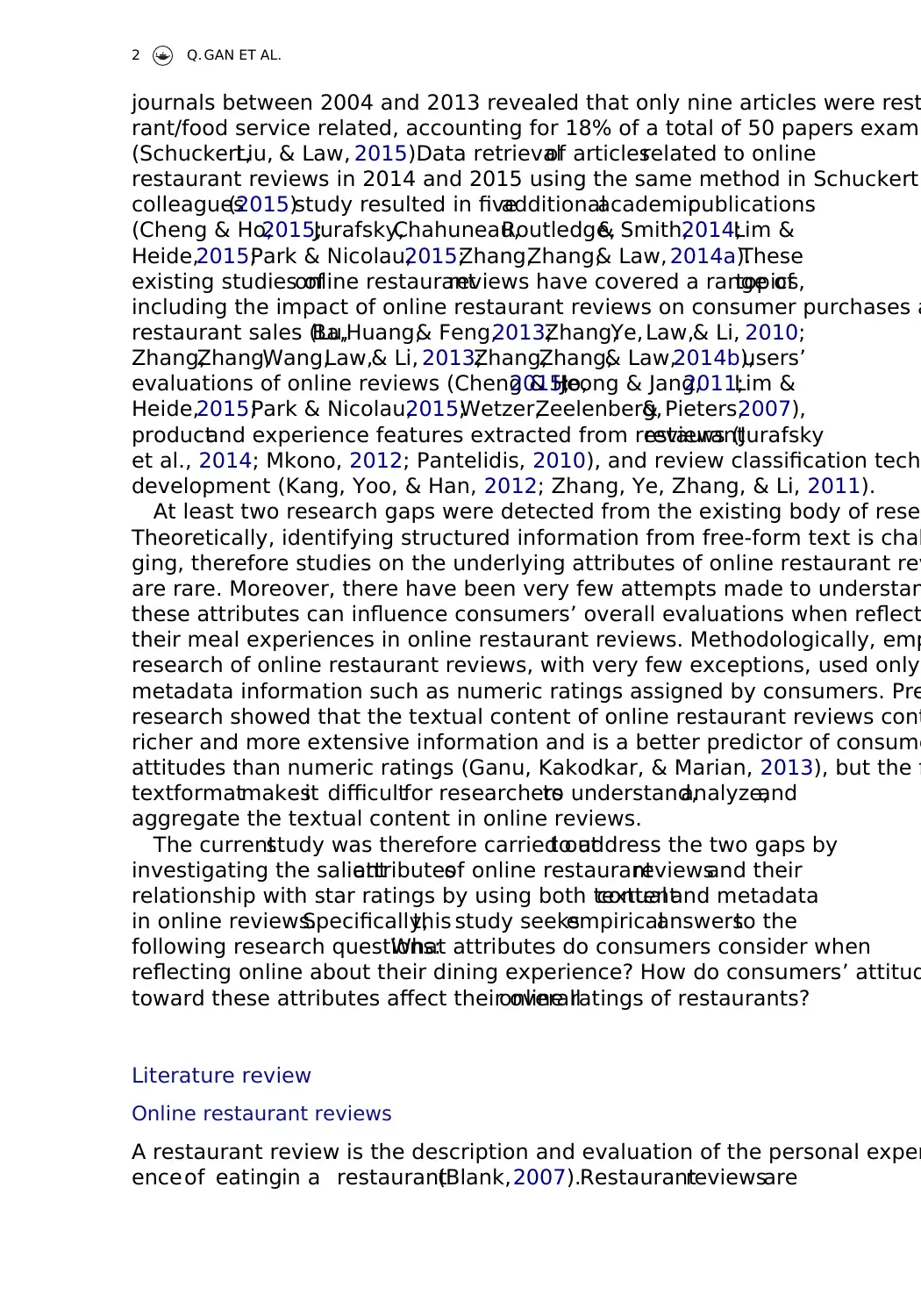
journals between 2004 and 2013 revealed that only nine articles were rest
rant/food service related, accounting for 18% of a total of 50 papers exami
(Schuckert,Liu, & Law, 2015).Data retrievalof articlesrelated to online
restaurant reviews in 2014 and 2015 using the same method in Schuckert
colleagues(2015)study resulted in fiveadditionalacademicpublications
(Cheng & Ho,2015;Jurafsky,Chahuneau,Routledge,& Smith,2014;Lim &
Heide,2015;Park & Nicolau,2015;Zhang,Zhang,& Law, 2014a).These
existing studies ofonline restaurantreviews have covered a range oftopics,
including the impact of online restaurant reviews on consumer purchases a
restaurant sales (Lu,Ba,Huang,& Feng,2013;Zhang,Ye, Law,& Li, 2010;
Zhang,Zhang,Wang,Law,& Li, 2013;Zhang,Zhang,& Law,2014b),users’
evaluations of online reviews (Cheng & Ho,2015;Jeong & Jang,2011;Lim &
Heide,2015;Park & Nicolau,2015;Wetzer,Zeelenberg,& Pieters,2007),
productand experience features extracted from restaurantreviews (Jurafsky
et al., 2014; Mkono, 2012; Pantelidis, 2010), and review classification techn
development (Kang, Yoo, & Han, 2012; Zhang, Ye, Zhang, & Li, 2011).
At least two research gaps were detected from the existing body of resea
Theoretically, identifying structured information from free-form text is chal
ging, therefore studies on the underlying attributes of online restaurant rev
are rare. Moreover, there have been very few attempts made to understan
these attributes can influence consumers’ overall evaluations when reflect
their meal experiences in online restaurant reviews. Methodologically, emp
research of online restaurant reviews, with very few exceptions, used only
metadata information such as numeric ratings assigned by consumers. Pre
research showed that the textual content of online restaurant reviews cont
richer and more extensive information and is a better predictor of consume
attitudes than numeric ratings (Ganu, Kakodkar, & Marian, 2013), but the f
textformatmakesit difficultfor researchersto understand,analyze,and
aggregate the textual content in online reviews.
The currentstudy was therefore carried outto address the two gaps by
investigating the salientattributesof online restaurantreviewsand their
relationship with star ratings by using both textualcontentand metadata
in online reviews.Specifically,this study seeksempiricalanswersto the
following research questions:What attributes do consumers consider when
reflecting online about their dining experience? How do consumers’ attitud
toward these attributes affect their overallonline ratings of restaurants?
Literature review
Online restaurant reviews
A restaurant review is the description and evaluation of the personal exper
enceof eatingin a restaurant(Blank,2007).Restaurantreviewsare
2 Q. GAN ET AL.
rant/food service related, accounting for 18% of a total of 50 papers exami
(Schuckert,Liu, & Law, 2015).Data retrievalof articlesrelated to online
restaurant reviews in 2014 and 2015 using the same method in Schuckert
colleagues(2015)study resulted in fiveadditionalacademicpublications
(Cheng & Ho,2015;Jurafsky,Chahuneau,Routledge,& Smith,2014;Lim &
Heide,2015;Park & Nicolau,2015;Zhang,Zhang,& Law, 2014a).These
existing studies ofonline restaurantreviews have covered a range oftopics,
including the impact of online restaurant reviews on consumer purchases a
restaurant sales (Lu,Ba,Huang,& Feng,2013;Zhang,Ye, Law,& Li, 2010;
Zhang,Zhang,Wang,Law,& Li, 2013;Zhang,Zhang,& Law,2014b),users’
evaluations of online reviews (Cheng & Ho,2015;Jeong & Jang,2011;Lim &
Heide,2015;Park & Nicolau,2015;Wetzer,Zeelenberg,& Pieters,2007),
productand experience features extracted from restaurantreviews (Jurafsky
et al., 2014; Mkono, 2012; Pantelidis, 2010), and review classification techn
development (Kang, Yoo, & Han, 2012; Zhang, Ye, Zhang, & Li, 2011).
At least two research gaps were detected from the existing body of resea
Theoretically, identifying structured information from free-form text is chal
ging, therefore studies on the underlying attributes of online restaurant rev
are rare. Moreover, there have been very few attempts made to understan
these attributes can influence consumers’ overall evaluations when reflect
their meal experiences in online restaurant reviews. Methodologically, emp
research of online restaurant reviews, with very few exceptions, used only
metadata information such as numeric ratings assigned by consumers. Pre
research showed that the textual content of online restaurant reviews cont
richer and more extensive information and is a better predictor of consume
attitudes than numeric ratings (Ganu, Kakodkar, & Marian, 2013), but the f
textformatmakesit difficultfor researchersto understand,analyze,and
aggregate the textual content in online reviews.
The currentstudy was therefore carried outto address the two gaps by
investigating the salientattributesof online restaurantreviewsand their
relationship with star ratings by using both textualcontentand metadata
in online reviews.Specifically,this study seeksempiricalanswersto the
following research questions:What attributes do consumers consider when
reflecting online about their dining experience? How do consumers’ attitud
toward these attributes affect their overallonline ratings of restaurants?
Literature review
Online restaurant reviews
A restaurant review is the description and evaluation of the personal exper
enceof eatingin a restaurant(Blank,2007).Restaurantreviewsare
2 Q. GAN ET AL.
⊘ This is a preview!⊘
Do you want full access?
Subscribe today to unlock all pages.

Trusted by 1+ million students worldwide
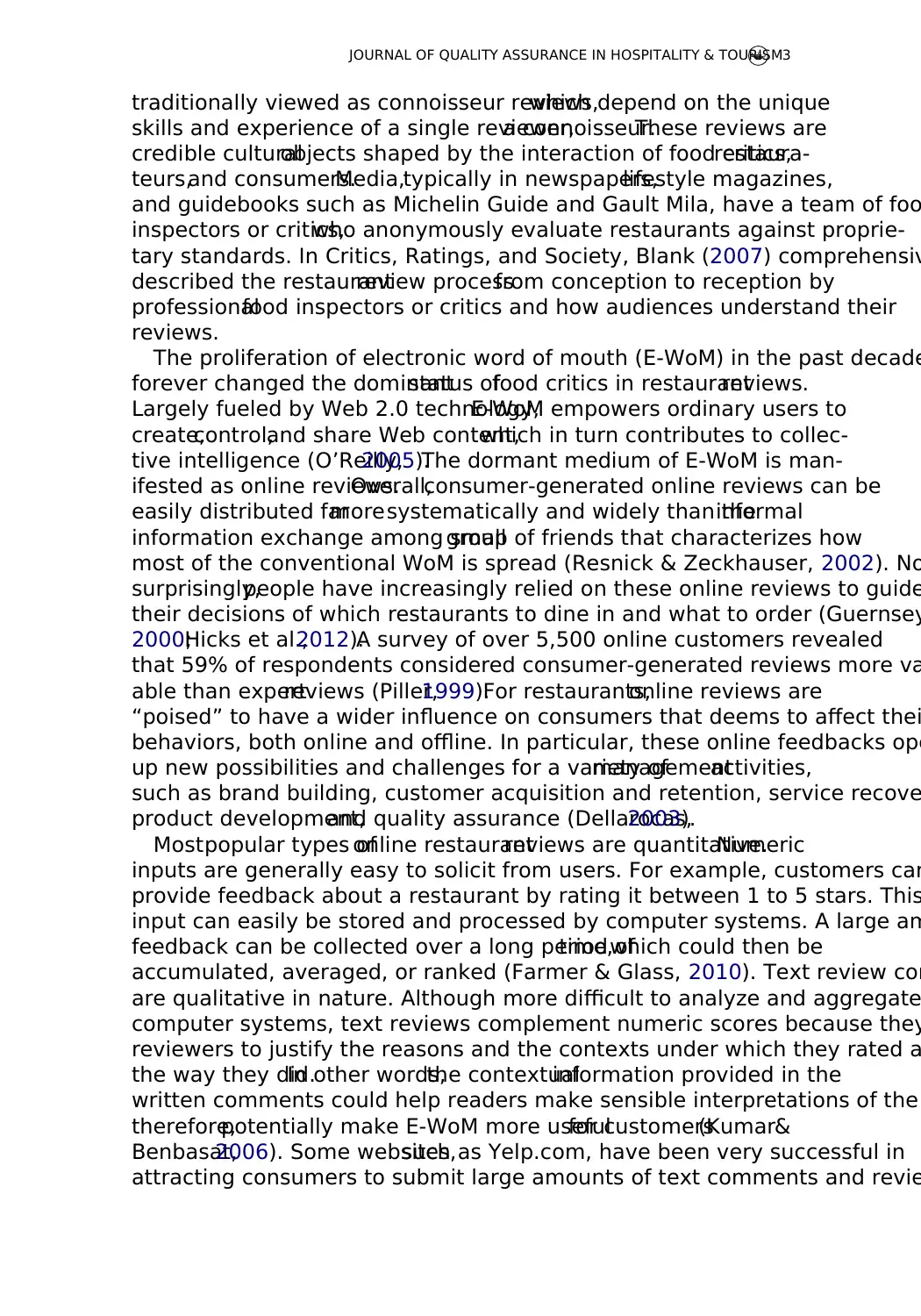
traditionally viewed as connoisseur reviews,which depend on the unique
skills and experience of a single reviewer,a connoisseur.These reviews are
credible culturalobjects shaped by the interaction of food critics,restaura-
teurs,and consumers.Media,typically in newspapers,lifestyle magazines,
and guidebooks such as Michelin Guide and Gault Mila, have a team of foo
inspectors or critics,who anonymously evaluate restaurants against proprie-
tary standards. In Critics, Ratings, and Society, Blank (2007) comprehensiv
described the restaurantreview processfrom conception to reception by
professionalfood inspectors or critics and how audiences understand their
reviews.
The proliferation of electronic word of mouth (E-WoM) in the past decade
forever changed the dominantstatus offood critics in restaurantreviews.
Largely fueled by Web 2.0 technology,E-WoM empowers ordinary users to
create,control,and share Web content,which in turn contributes to collec-
tive intelligence (O’Reilly,2005).The dormant medium of E-WoM is man-
ifested as online reviews.Overall,consumer-generated online reviews can be
easily distributed farmoresystematically and widely than theinformal
information exchange among smallgroup of friends that characterizes how
most of the conventional WoM is spread (Resnick & Zeckhauser, 2002). No
surprisingly,people have increasingly relied on these online reviews to guide
their decisions of which restaurants to dine in and what to order (Guernsey
2000;Hicks et al.,2012).A survey of over 5,500 online customers revealed
that 59% of respondents considered consumer-generated reviews more va
able than expertreviews (Piller,1999).For restaurants,online reviews are
“poised” to have a wider influence on consumers that deems to affect thei
behaviors, both online and offline. In particular, these online feedbacks ope
up new possibilities and challenges for a variety ofmanagementactivities,
such as brand building, customer acquisition and retention, service recove
product development,and quality assurance (Dellarocas,2003).
Mostpopular types ofonline restaurantreviews are quantitative.Numeric
inputs are generally easy to solicit from users. For example, customers can
provide feedback about a restaurant by rating it between 1 to 5 stars. This
input can easily be stored and processed by computer systems. A large am
feedback can be collected over a long period oftime,which could then be
accumulated, averaged, or ranked (Farmer & Glass, 2010). Text review com
are qualitative in nature. Although more difficult to analyze and aggregate
computer systems, text reviews complement numeric scores because they
reviewers to justify the reasons and the contexts under which they rated a
the way they did.In other words,the contextualinformation provided in the
written comments could help readers make sensible interpretations of the
therefore,potentially make E-WoM more usefulfor customers(Kumar&
Benbasat,2006). Some websites,such as Yelp.com, have been very successful in
attracting consumers to submit large amounts of text comments and revie
JOURNAL OF QUALITY ASSURANCE IN HOSPITALITY & TOURISM3
skills and experience of a single reviewer,a connoisseur.These reviews are
credible culturalobjects shaped by the interaction of food critics,restaura-
teurs,and consumers.Media,typically in newspapers,lifestyle magazines,
and guidebooks such as Michelin Guide and Gault Mila, have a team of foo
inspectors or critics,who anonymously evaluate restaurants against proprie-
tary standards. In Critics, Ratings, and Society, Blank (2007) comprehensiv
described the restaurantreview processfrom conception to reception by
professionalfood inspectors or critics and how audiences understand their
reviews.
The proliferation of electronic word of mouth (E-WoM) in the past decade
forever changed the dominantstatus offood critics in restaurantreviews.
Largely fueled by Web 2.0 technology,E-WoM empowers ordinary users to
create,control,and share Web content,which in turn contributes to collec-
tive intelligence (O’Reilly,2005).The dormant medium of E-WoM is man-
ifested as online reviews.Overall,consumer-generated online reviews can be
easily distributed farmoresystematically and widely than theinformal
information exchange among smallgroup of friends that characterizes how
most of the conventional WoM is spread (Resnick & Zeckhauser, 2002). No
surprisingly,people have increasingly relied on these online reviews to guide
their decisions of which restaurants to dine in and what to order (Guernsey
2000;Hicks et al.,2012).A survey of over 5,500 online customers revealed
that 59% of respondents considered consumer-generated reviews more va
able than expertreviews (Piller,1999).For restaurants,online reviews are
“poised” to have a wider influence on consumers that deems to affect thei
behaviors, both online and offline. In particular, these online feedbacks ope
up new possibilities and challenges for a variety ofmanagementactivities,
such as brand building, customer acquisition and retention, service recove
product development,and quality assurance (Dellarocas,2003).
Mostpopular types ofonline restaurantreviews are quantitative.Numeric
inputs are generally easy to solicit from users. For example, customers can
provide feedback about a restaurant by rating it between 1 to 5 stars. This
input can easily be stored and processed by computer systems. A large am
feedback can be collected over a long period oftime,which could then be
accumulated, averaged, or ranked (Farmer & Glass, 2010). Text review com
are qualitative in nature. Although more difficult to analyze and aggregate
computer systems, text reviews complement numeric scores because they
reviewers to justify the reasons and the contexts under which they rated a
the way they did.In other words,the contextualinformation provided in the
written comments could help readers make sensible interpretations of the
therefore,potentially make E-WoM more usefulfor customers(Kumar&
Benbasat,2006). Some websites,such as Yelp.com, have been very successful in
attracting consumers to submit large amounts of text comments and revie
JOURNAL OF QUALITY ASSURANCE IN HOSPITALITY & TOURISM3
Paraphrase This Document
Need a fresh take? Get an instant paraphrase of this document with our AI Paraphraser
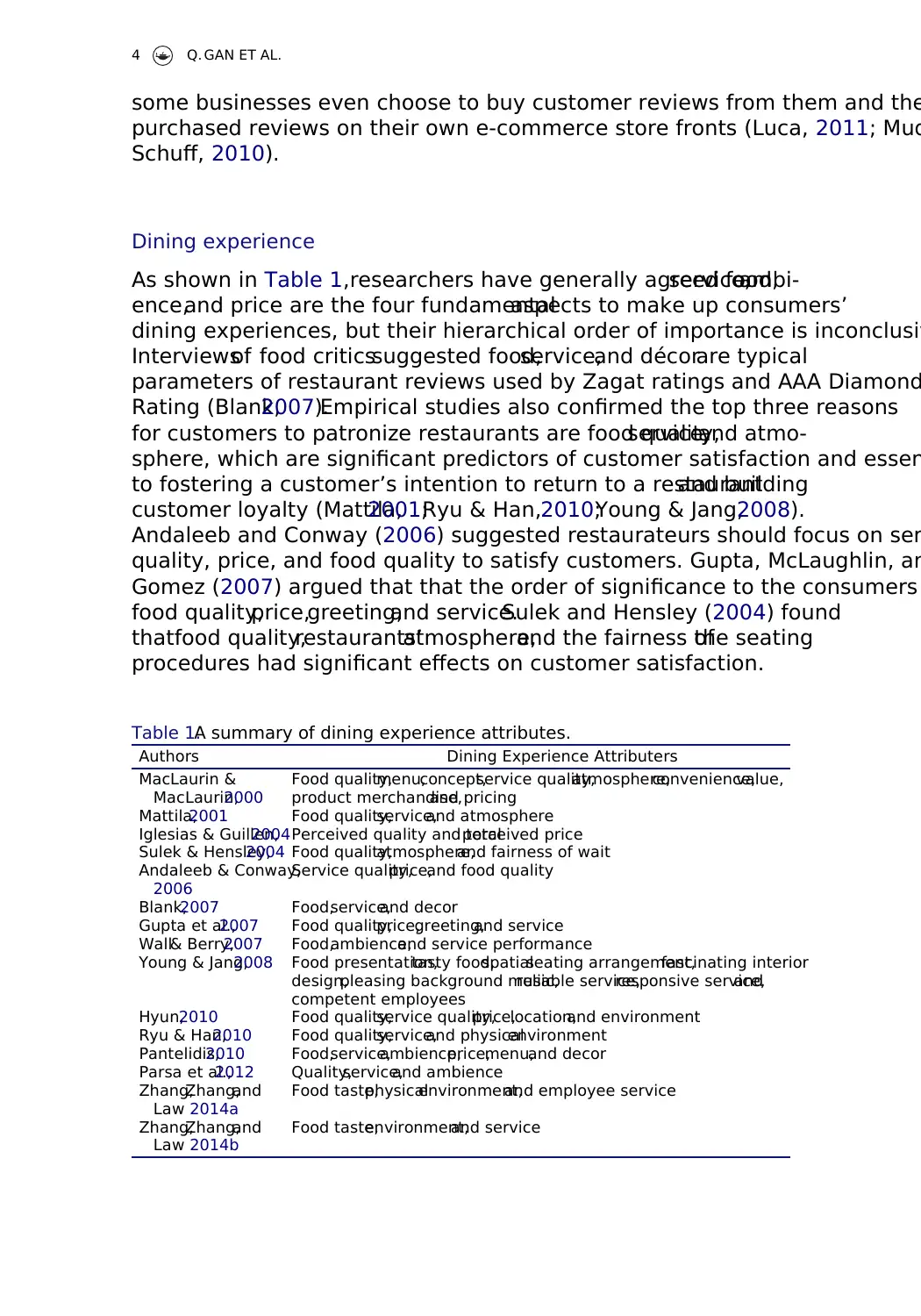
some businesses even choose to buy customer reviews from them and the
purchased reviews on their own e-commerce store fronts (Luca, 2011; Mud
Schuff, 2010).
Dining experience
As shown in Table 1,researchers have generally agreed food,service,ambi-
ence,and price are the four fundamentalaspects to make up consumers’
dining experiences, but their hierarchical order of importance is inconclusiv
Interviewsof food criticssuggested food,service,and décorare typical
parameters of restaurant reviews used by Zagat ratings and AAA Diamond
Rating (Blank,2007).Empirical studies also confirmed the top three reasons
for customers to patronize restaurants are food quality,service,and atmo-
sphere, which are significant predictors of customer satisfaction and essen
to fostering a customer’s intention to return to a restaurantand building
customer loyalty (Mattila,2001;Ryu & Han,2010;Young & Jang,2008).
Andaleeb and Conway (2006) suggested restaurateurs should focus on ser
quality, price, and food quality to satisfy customers. Gupta, McLaughlin, an
Gomez (2007) argued that that the order of significance to the consumers
food quality,price,greeting,and service.Sulek and Hensley (2004) found
thatfood quality,restaurants’atmosphere,and the fairness ofthe seating
procedures had significant effects on customer satisfaction.
Table 1.A summary of dining experience attributes.
Authors Dining Experience Attributers
MacLaurin &
MacLaurin,2000
Food quality,menu,concept,service quality,atmosphere,convenience,value,
product merchandise,and pricing
Mattila,2001 Food quality,service,and atmosphere
Iglesias & Guillen,2004Perceived quality and totalperceived price
Sulek & Hensley,2004 Food quality,atmosphere,and fairness of wait
Andaleeb & Conway,
2006
Service quality,price,and food quality
Blank,2007 Food,service,and decor
Gupta et al.,2007 Food quality,price,greeting,and service
Wall& Berry,2007 Food,ambience,and service performance
Young & Jang,2008 Food presentation,tasty food,spatialseating arrangement,fascinating interior
design,pleasing background music,reliable service,responsive service,and
competent employees
Hyun,2010 Food quality,service quality,price,location,and environment
Ryu & Han,2010 Food quality,service,and physicalenvironment
Pantelidis,2010 Food,service,ambience,price,menu,and decor
Parsa et al.,2012 Quality,service,and ambience
Zhang,Zhang,and
Law 2014a
Food taste,physicalenvironment,and employee service
Zhang,Zhang,and
Law 2014b
Food taste,environment,and service
4 Q. GAN ET AL.
purchased reviews on their own e-commerce store fronts (Luca, 2011; Mud
Schuff, 2010).
Dining experience
As shown in Table 1,researchers have generally agreed food,service,ambi-
ence,and price are the four fundamentalaspects to make up consumers’
dining experiences, but their hierarchical order of importance is inconclusiv
Interviewsof food criticssuggested food,service,and décorare typical
parameters of restaurant reviews used by Zagat ratings and AAA Diamond
Rating (Blank,2007).Empirical studies also confirmed the top three reasons
for customers to patronize restaurants are food quality,service,and atmo-
sphere, which are significant predictors of customer satisfaction and essen
to fostering a customer’s intention to return to a restaurantand building
customer loyalty (Mattila,2001;Ryu & Han,2010;Young & Jang,2008).
Andaleeb and Conway (2006) suggested restaurateurs should focus on ser
quality, price, and food quality to satisfy customers. Gupta, McLaughlin, an
Gomez (2007) argued that that the order of significance to the consumers
food quality,price,greeting,and service.Sulek and Hensley (2004) found
thatfood quality,restaurants’atmosphere,and the fairness ofthe seating
procedures had significant effects on customer satisfaction.
Table 1.A summary of dining experience attributes.
Authors Dining Experience Attributers
MacLaurin &
MacLaurin,2000
Food quality,menu,concept,service quality,atmosphere,convenience,value,
product merchandise,and pricing
Mattila,2001 Food quality,service,and atmosphere
Iglesias & Guillen,2004Perceived quality and totalperceived price
Sulek & Hensley,2004 Food quality,atmosphere,and fairness of wait
Andaleeb & Conway,
2006
Service quality,price,and food quality
Blank,2007 Food,service,and decor
Gupta et al.,2007 Food quality,price,greeting,and service
Wall& Berry,2007 Food,ambience,and service performance
Young & Jang,2008 Food presentation,tasty food,spatialseating arrangement,fascinating interior
design,pleasing background music,reliable service,responsive service,and
competent employees
Hyun,2010 Food quality,service quality,price,location,and environment
Ryu & Han,2010 Food quality,service,and physicalenvironment
Pantelidis,2010 Food,service,ambience,price,menu,and decor
Parsa et al.,2012 Quality,service,and ambience
Zhang,Zhang,and
Law 2014a
Food taste,physicalenvironment,and employee service
Zhang,Zhang,and
Law 2014b
Food taste,environment,and service
4 Q. GAN ET AL.
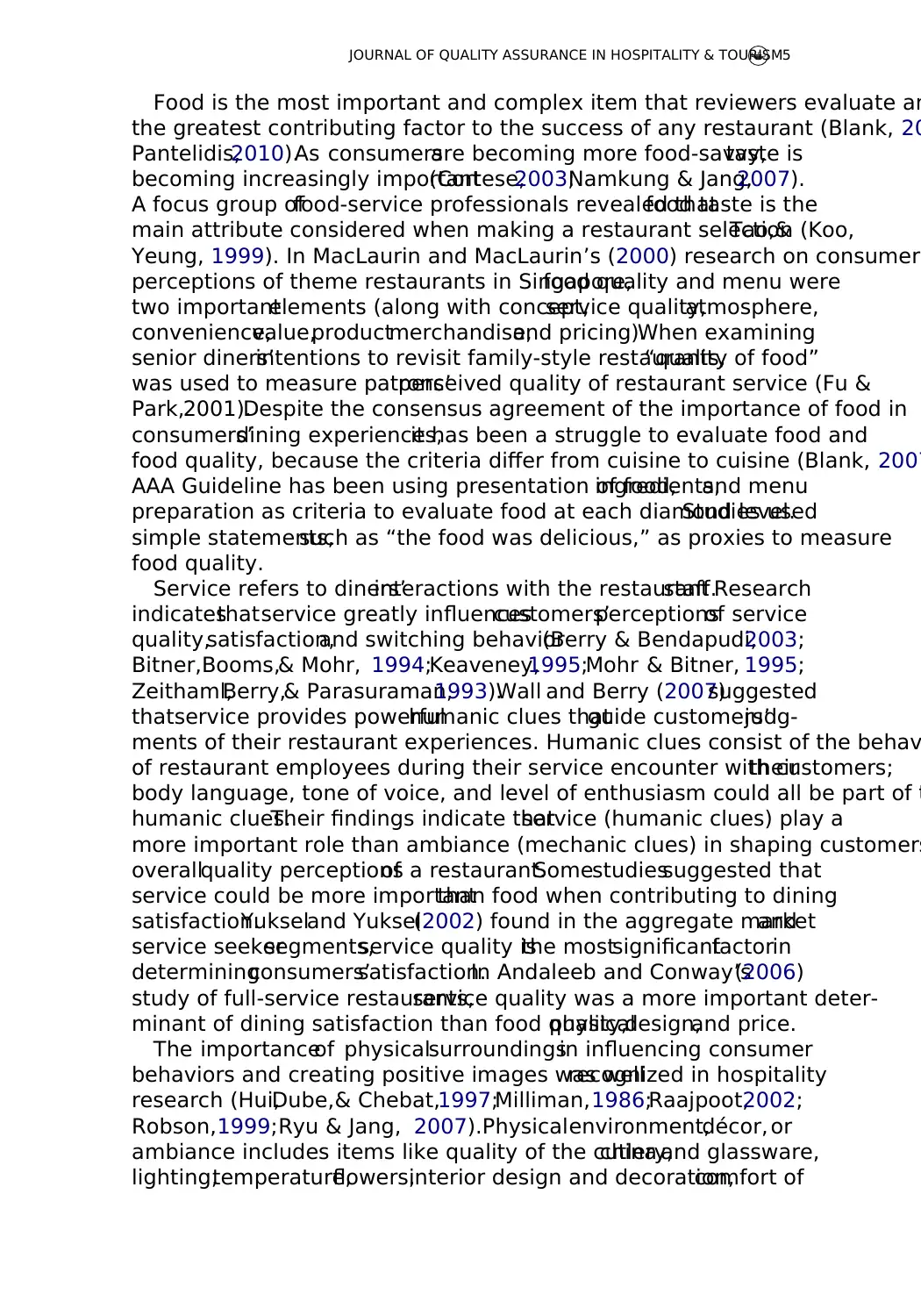
Food is the most important and complex item that reviewers evaluate an
the greatest contributing factor to the success of any restaurant (Blank, 20
Pantelidis,2010).As consumersare becoming more food-savvy,taste is
becoming increasingly important(Cortese,2003;Namkung & Jang,2007).
A focus group offood-service professionals revealed thatfood taste is the
main attribute considered when making a restaurant selection (Koo,Tao,&
Yeung, 1999). In MacLaurin and MacLaurin’s (2000) research on consumers
perceptions of theme restaurants in Singapore,food quality and menu were
two importantelements (along with concept,service quality,atmosphere,
convenience,value,productmerchandise,and pricing).When examining
senior diners’intentions to revisit family-style restaurants,“quality of food”
was used to measure patrons’perceived quality of restaurant service (Fu &
Park,2001).Despite the consensus agreement of the importance of food in
consumers’dining experiences,it has been a struggle to evaluate food and
food quality, because the criteria differ from cuisine to cuisine (Blank, 2007
AAA Guideline has been using presentation of food,ingredients,and menu
preparation as criteria to evaluate food at each diamond level.Studies used
simple statements,such as “the food was delicious,” as proxies to measure
food quality.
Service refers to diners’interactions with the restaurantstaff.Research
indicatesthatservice greatly influencescustomers’perceptionsof service
quality,satisfaction,and switching behavior(Berry & Bendapudi,2003;
Bitner,Booms,& Mohr, 1994;Keaveney,1995;Mohr & Bitner, 1995;
Zeithaml,Berry,& Parasuraman,1993).Wall and Berry (2007)suggested
thatservice provides powerfulhumanic clues thatguide customers’judg-
ments of their restaurant experiences. Humanic clues consist of the behav
of restaurant employees during their service encounter with customers;their
body language, tone of voice, and level of enthusiasm could all be part of t
humanic clues.Their findings indicate thatservice (humanic clues) play a
more important role than ambiance (mechanic clues) in shaping customers
overallquality perceptionsof a restaurant.Somestudiessuggested that
service could be more importantthan food when contributing to dining
satisfaction.Yukseland Yuksel(2002) found in the aggregate marketand
service seekersegments,service quality isthe mostsignificantfactorin
determiningconsumers’satisfaction.In Andaleeb and Conway’s(2006)
study of full-service restaurants,service quality was a more important deter-
minant of dining satisfaction than food quality,physicaldesign,and price.
The importanceof physicalsurroundingsin influencing consumer
behaviors and creating positive images was wellrecognized in hospitality
research (Hui,Dube,& Chebat,1997;Milliman,1986;Raajpoot,2002;
Robson,1999;Ryu & Jang, 2007).Physicalenvironment,décor, or
ambiance includes items like quality of the cutlery,china,and glassware,
lighting,temperature,flowers,interior design and decoration,comfort of
JOURNAL OF QUALITY ASSURANCE IN HOSPITALITY & TOURISM5
the greatest contributing factor to the success of any restaurant (Blank, 20
Pantelidis,2010).As consumersare becoming more food-savvy,taste is
becoming increasingly important(Cortese,2003;Namkung & Jang,2007).
A focus group offood-service professionals revealed thatfood taste is the
main attribute considered when making a restaurant selection (Koo,Tao,&
Yeung, 1999). In MacLaurin and MacLaurin’s (2000) research on consumers
perceptions of theme restaurants in Singapore,food quality and menu were
two importantelements (along with concept,service quality,atmosphere,
convenience,value,productmerchandise,and pricing).When examining
senior diners’intentions to revisit family-style restaurants,“quality of food”
was used to measure patrons’perceived quality of restaurant service (Fu &
Park,2001).Despite the consensus agreement of the importance of food in
consumers’dining experiences,it has been a struggle to evaluate food and
food quality, because the criteria differ from cuisine to cuisine (Blank, 2007
AAA Guideline has been using presentation of food,ingredients,and menu
preparation as criteria to evaluate food at each diamond level.Studies used
simple statements,such as “the food was delicious,” as proxies to measure
food quality.
Service refers to diners’interactions with the restaurantstaff.Research
indicatesthatservice greatly influencescustomers’perceptionsof service
quality,satisfaction,and switching behavior(Berry & Bendapudi,2003;
Bitner,Booms,& Mohr, 1994;Keaveney,1995;Mohr & Bitner, 1995;
Zeithaml,Berry,& Parasuraman,1993).Wall and Berry (2007)suggested
thatservice provides powerfulhumanic clues thatguide customers’judg-
ments of their restaurant experiences. Humanic clues consist of the behav
of restaurant employees during their service encounter with customers;their
body language, tone of voice, and level of enthusiasm could all be part of t
humanic clues.Their findings indicate thatservice (humanic clues) play a
more important role than ambiance (mechanic clues) in shaping customers
overallquality perceptionsof a restaurant.Somestudiessuggested that
service could be more importantthan food when contributing to dining
satisfaction.Yukseland Yuksel(2002) found in the aggregate marketand
service seekersegments,service quality isthe mostsignificantfactorin
determiningconsumers’satisfaction.In Andaleeb and Conway’s(2006)
study of full-service restaurants,service quality was a more important deter-
minant of dining satisfaction than food quality,physicaldesign,and price.
The importanceof physicalsurroundingsin influencing consumer
behaviors and creating positive images was wellrecognized in hospitality
research (Hui,Dube,& Chebat,1997;Milliman,1986;Raajpoot,2002;
Robson,1999;Ryu & Jang, 2007).Physicalenvironment,décor, or
ambiance includes items like quality of the cutlery,china,and glassware,
lighting,temperature,flowers,interior design and decoration,comfort of
JOURNAL OF QUALITY ASSURANCE IN HOSPITALITY & TOURISM5
⊘ This is a preview!⊘
Do you want full access?
Subscribe today to unlock all pages.

Trusted by 1+ million students worldwide
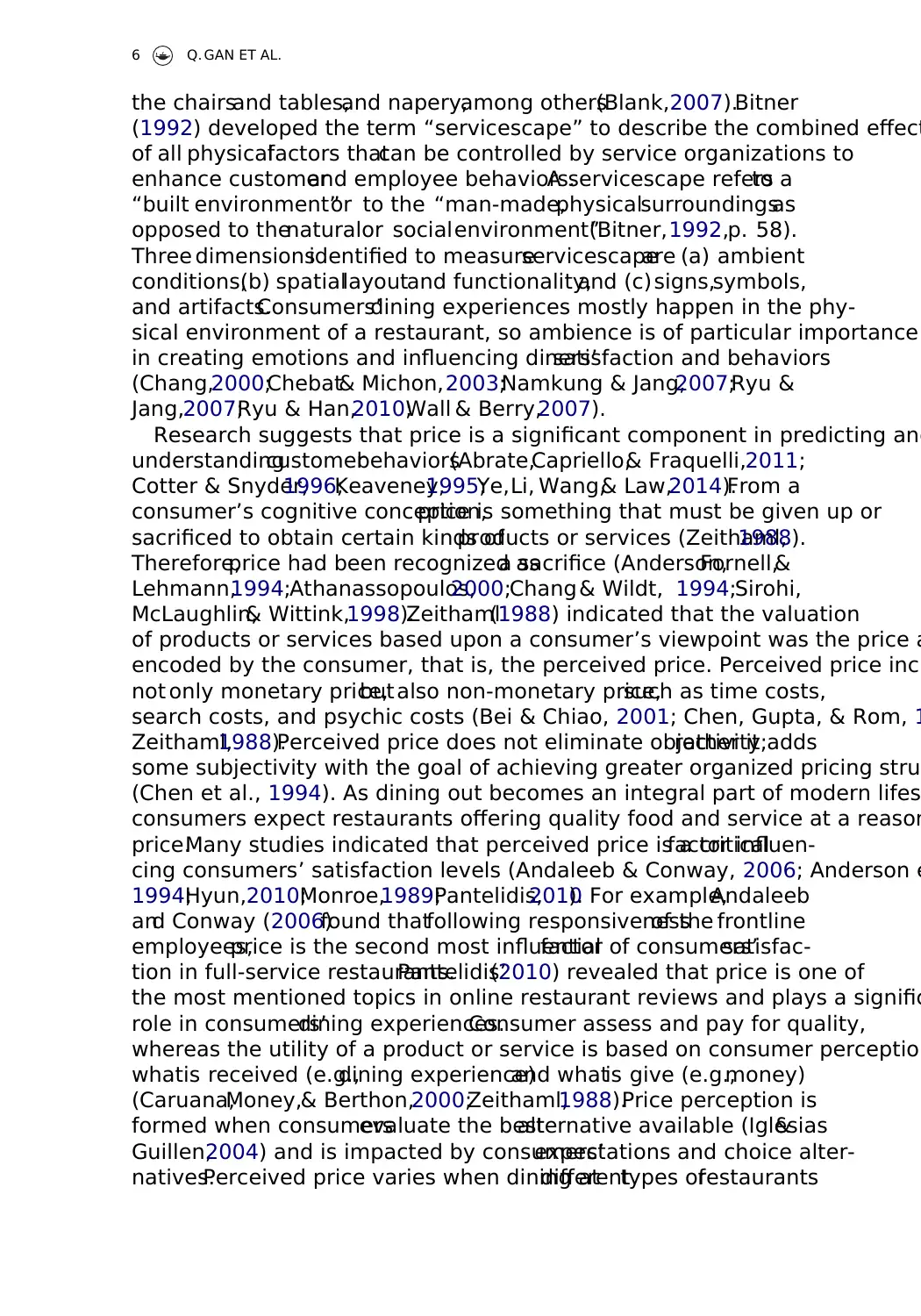
the chairsand tables,and napery,among others(Blank,2007).Bitner
(1992) developed the term “servicescape” to describe the combined effect
of all physicalfactors thatcan be controlled by service organizations to
enhance customerand employee behaviors.A servicescape refersto a
“built environment”or to the “man-made,physicalsurroundingsas
opposed to thenaturalor socialenvironment”(Bitner,1992,p. 58).
Three dimensionsidentified to measureservicescapeare (a) ambient
conditions,(b) spatiallayoutand functionality,and (c)signs,symbols,
and artifacts.Consumers’dining experiences mostly happen in the phy-
sical environment of a restaurant, so ambience is of particular importance
in creating emotions and influencing diners’satisfaction and behaviors
(Chang,2000;Chebat& Michon,2003;Namkung & Jang,2007;Ryu &
Jang,2007;Ryu & Han,2010;Wall & Berry,2007).
Research suggests that price is a significant component in predicting and
understandingcustomerbehaviors(Abrate,Capriello,& Fraquelli,2011;
Cotter & Snyder,1996;Keaveney,1995;Ye,Li, Wang,& Law,2014).From a
consumer’s cognitive conception,price is something that must be given up or
sacrificed to obtain certain kinds ofproducts or services (Zeithaml,1988).
Therefore,price had been recognized asa sacrifice (Anderson,Fornell,&
Lehmann,1994;Athanassopoulos,2000;Chang& Wildt, 1994;Sirohi,
McLaughlin,& Wittink,1998).Zeithaml(1988) indicated that the valuation
of products or services based upon a consumer’s viewpoint was the price a
encoded by the consumer, that is, the perceived price. Perceived price incl
not only monetary price,but also non-monetary price,such as time costs,
search costs, and psychic costs (Bei & Chiao, 2001; Chen, Gupta, & Rom, 1
Zeithaml,1988).Perceived price does not eliminate objectivity;rather it adds
some subjectivity with the goal of achieving greater organized pricing struc
(Chen et al., 1994). As dining out becomes an integral part of modern lifes
consumers expect restaurants offering quality food and service at a reason
price.Many studies indicated that perceived price is a criticalfactor influen-
cing consumers’ satisfaction levels (Andaleeb & Conway, 2006; Anderson e
1994;Hyun,2010;Monroe,1989;Pantelidis,2010). For example,Andaleeb
and Conway (2006)found thatfollowing responsivenessof the frontline
employees,price is the second most influentialfactor of consumers’satisfac-
tion in full-service restaurants.Pantelidis’(2010) revealed that price is one of
the most mentioned topics in online restaurant reviews and plays a signific
role in consumers’dining experiences.Consumer assess and pay for quality,
whereas the utility of a product or service is based on consumer perception
whatis received (e.g.,dining experience)and whatis give (e.g.,money)
(Caruana,Money,& Berthon,2000;Zeithaml,1988).Price perception is
formed when consumersevaluate the bestalternative available (Iglesias&
Guillen,2004) and is impacted by consumers’expectations and choice alter-
natives.Perceived price varies when dining atdifferenttypes ofrestaurants
6 Q. GAN ET AL.
(1992) developed the term “servicescape” to describe the combined effect
of all physicalfactors thatcan be controlled by service organizations to
enhance customerand employee behaviors.A servicescape refersto a
“built environment”or to the “man-made,physicalsurroundingsas
opposed to thenaturalor socialenvironment”(Bitner,1992,p. 58).
Three dimensionsidentified to measureservicescapeare (a) ambient
conditions,(b) spatiallayoutand functionality,and (c)signs,symbols,
and artifacts.Consumers’dining experiences mostly happen in the phy-
sical environment of a restaurant, so ambience is of particular importance
in creating emotions and influencing diners’satisfaction and behaviors
(Chang,2000;Chebat& Michon,2003;Namkung & Jang,2007;Ryu &
Jang,2007;Ryu & Han,2010;Wall & Berry,2007).
Research suggests that price is a significant component in predicting and
understandingcustomerbehaviors(Abrate,Capriello,& Fraquelli,2011;
Cotter & Snyder,1996;Keaveney,1995;Ye,Li, Wang,& Law,2014).From a
consumer’s cognitive conception,price is something that must be given up or
sacrificed to obtain certain kinds ofproducts or services (Zeithaml,1988).
Therefore,price had been recognized asa sacrifice (Anderson,Fornell,&
Lehmann,1994;Athanassopoulos,2000;Chang& Wildt, 1994;Sirohi,
McLaughlin,& Wittink,1998).Zeithaml(1988) indicated that the valuation
of products or services based upon a consumer’s viewpoint was the price a
encoded by the consumer, that is, the perceived price. Perceived price incl
not only monetary price,but also non-monetary price,such as time costs,
search costs, and psychic costs (Bei & Chiao, 2001; Chen, Gupta, & Rom, 1
Zeithaml,1988).Perceived price does not eliminate objectivity;rather it adds
some subjectivity with the goal of achieving greater organized pricing struc
(Chen et al., 1994). As dining out becomes an integral part of modern lifes
consumers expect restaurants offering quality food and service at a reason
price.Many studies indicated that perceived price is a criticalfactor influen-
cing consumers’ satisfaction levels (Andaleeb & Conway, 2006; Anderson e
1994;Hyun,2010;Monroe,1989;Pantelidis,2010). For example,Andaleeb
and Conway (2006)found thatfollowing responsivenessof the frontline
employees,price is the second most influentialfactor of consumers’satisfac-
tion in full-service restaurants.Pantelidis’(2010) revealed that price is one of
the most mentioned topics in online restaurant reviews and plays a signific
role in consumers’dining experiences.Consumer assess and pay for quality,
whereas the utility of a product or service is based on consumer perception
whatis received (e.g.,dining experience)and whatis give (e.g.,money)
(Caruana,Money,& Berthon,2000;Zeithaml,1988).Price perception is
formed when consumersevaluate the bestalternative available (Iglesias&
Guillen,2004) and is impacted by consumers’expectations and choice alter-
natives.Perceived price varies when dining atdifferenttypes ofrestaurants
6 Q. GAN ET AL.
Paraphrase This Document
Need a fresh take? Get an instant paraphrase of this document with our AI Paraphraser
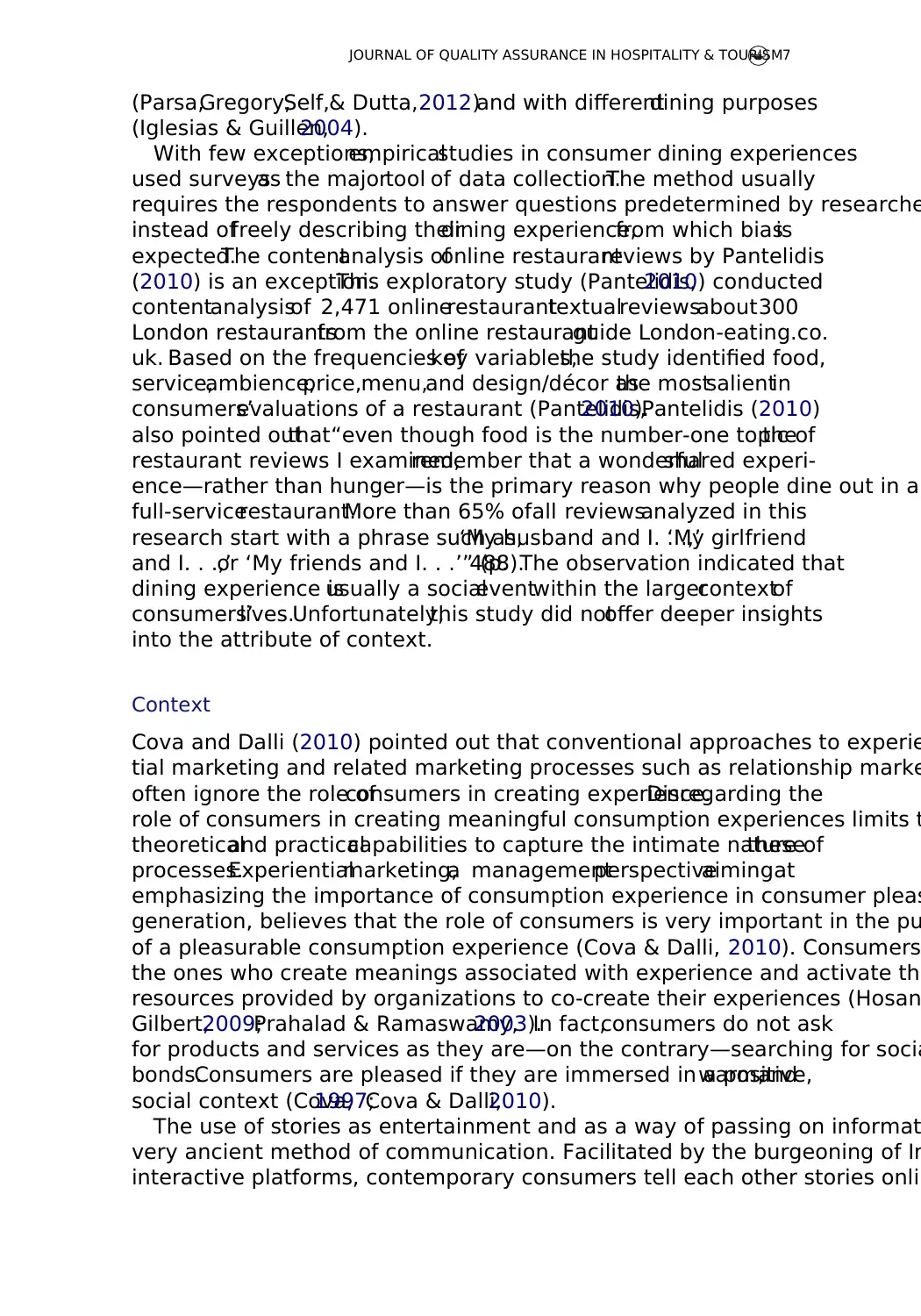
(Parsa,Gregory,Self,& Dutta,2012)and with differentdining purposes
(Iglesias & Guillen,2004).
With few exceptions,empiricalstudies in consumer dining experiences
used surveysas the majortool of data collection.The method usually
requires the respondents to answer questions predetermined by researche
instead offreely describing theirdining experience,from which biasis
expected.The contentanalysis ofonline restaurantreviews by Pantelidis
(2010) is an exception.This exploratory study (Pantelidis,2010) conducted
contentanalysisof 2,471 onlinerestauranttextualreviewsabout300
London restaurantsfrom the online restaurantguide London-eating.co.
uk. Based on the frequencies ofkey variables,the study identified food,
service,ambience,price,menu,and design/décor asthe mostsalientin
consumers’evaluations of a restaurant (Pantelidis,2010).Pantelidis (2010)
also pointed outthat“even though food is the number-one topic ofthe
restaurant reviews I examined,remember that a wonderfulshared experi-
ence—rather than hunger—is the primary reason why people dine out in a
full-servicerestaurant.More than 65% ofall reviewsanalyzed in this
research start with a phrase such as,‘My husband and I. . .,’‘My girlfriend
and I. . .,’or ‘My friends and I. . .’” (p.488).The observation indicated that
dining experience isusually a socialeventwithin the largercontextof
consumers’lives.Unfortunately,this study did notoffer deeper insights
into the attribute of context.
Context
Cova and Dalli (2010) pointed out that conventional approaches to experie
tial marketing and related marketing processes such as relationship marke
often ignore the role ofconsumers in creating experience.Disregarding the
role of consumers in creating meaningful consumption experiences limits t
theoreticaland practicalcapabilities to capture the intimate nature ofthese
processes.Experientialmarketing,a managementperspectiveaimingat
emphasizing the importance of consumption experience in consumer pleas
generation, believes that the role of consumers is very important in the pu
of a pleasurable consumption experience (Cova & Dalli, 2010). Consumers
the ones who create meanings associated with experience and activate the
resources provided by organizations to co-create their experiences (Hosan
Gilbert,2009;Prahalad & Ramaswamy,2003).In fact,consumers do not ask
for products and services as they are—on the contrary—searching for socia
bonds.Consumers are pleased if they are immersed in a positive,warm,and
social context (Cova,1997;Cova & Dalli,2010).
The use of stories as entertainment and as a way of passing on informat
very ancient method of communication. Facilitated by the burgeoning of In
interactive platforms, contemporary consumers tell each other stories onlin
JOURNAL OF QUALITY ASSURANCE IN HOSPITALITY & TOURISM7
(Iglesias & Guillen,2004).
With few exceptions,empiricalstudies in consumer dining experiences
used surveysas the majortool of data collection.The method usually
requires the respondents to answer questions predetermined by researche
instead offreely describing theirdining experience,from which biasis
expected.The contentanalysis ofonline restaurantreviews by Pantelidis
(2010) is an exception.This exploratory study (Pantelidis,2010) conducted
contentanalysisof 2,471 onlinerestauranttextualreviewsabout300
London restaurantsfrom the online restaurantguide London-eating.co.
uk. Based on the frequencies ofkey variables,the study identified food,
service,ambience,price,menu,and design/décor asthe mostsalientin
consumers’evaluations of a restaurant (Pantelidis,2010).Pantelidis (2010)
also pointed outthat“even though food is the number-one topic ofthe
restaurant reviews I examined,remember that a wonderfulshared experi-
ence—rather than hunger—is the primary reason why people dine out in a
full-servicerestaurant.More than 65% ofall reviewsanalyzed in this
research start with a phrase such as,‘My husband and I. . .,’‘My girlfriend
and I. . .,’or ‘My friends and I. . .’” (p.488).The observation indicated that
dining experience isusually a socialeventwithin the largercontextof
consumers’lives.Unfortunately,this study did notoffer deeper insights
into the attribute of context.
Context
Cova and Dalli (2010) pointed out that conventional approaches to experie
tial marketing and related marketing processes such as relationship marke
often ignore the role ofconsumers in creating experience.Disregarding the
role of consumers in creating meaningful consumption experiences limits t
theoreticaland practicalcapabilities to capture the intimate nature ofthese
processes.Experientialmarketing,a managementperspectiveaimingat
emphasizing the importance of consumption experience in consumer pleas
generation, believes that the role of consumers is very important in the pu
of a pleasurable consumption experience (Cova & Dalli, 2010). Consumers
the ones who create meanings associated with experience and activate the
resources provided by organizations to co-create their experiences (Hosan
Gilbert,2009;Prahalad & Ramaswamy,2003).In fact,consumers do not ask
for products and services as they are—on the contrary—searching for socia
bonds.Consumers are pleased if they are immersed in a positive,warm,and
social context (Cova,1997;Cova & Dalli,2010).
The use of stories as entertainment and as a way of passing on informat
very ancient method of communication. Facilitated by the burgeoning of In
interactive platforms, contemporary consumers tell each other stories onlin
JOURNAL OF QUALITY ASSURANCE IN HOSPITALITY & TOURISM7
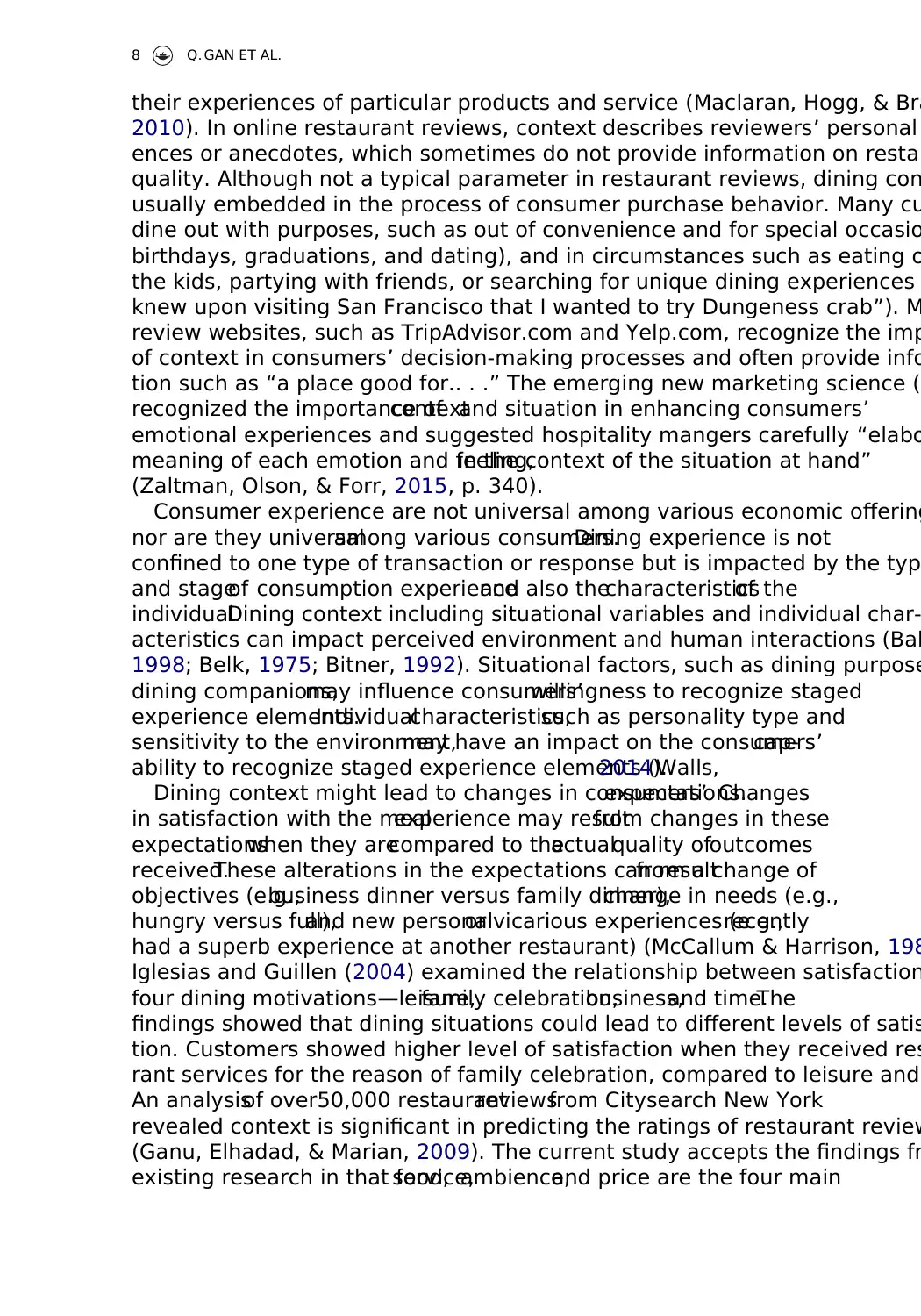
their experiences of particular products and service (Maclaran, Hogg, & Bra
2010). In online restaurant reviews, context describes reviewers’ personal
ences or anecdotes, which sometimes do not provide information on restau
quality. Although not a typical parameter in restaurant reviews, dining con
usually embedded in the process of consumer purchase behavior. Many cu
dine out with purposes, such as out of convenience and for special occasio
birthdays, graduations, and dating), and in circumstances such as eating o
the kids, partying with friends, or searching for unique dining experiences
knew upon visiting San Francisco that I wanted to try Dungeness crab”). M
review websites, such as TripAdvisor.com and Yelp.com, recognize the imp
of context in consumers’ decision-making processes and often provide info
tion such as “a place good for.. . .” The emerging new marketing science (N
recognized the importance ofcontextand situation in enhancing consumers’
emotional experiences and suggested hospitality mangers carefully “elabo
meaning of each emotion and feeling,in the context of the situation at hand”
(Zaltman, Olson, & Forr, 2015, p. 340).
Consumer experience are not universal among various economic offering
nor are they universalamong various consumers.Dining experience is not
confined to one type of transaction or response but is impacted by the typ
and stageof consumption experienceand also thecharacteristicsof the
individual.Dining context including situational variables and individual char-
acteristics can impact perceived environment and human interactions (Bak
1998; Belk, 1975; Bitner, 1992). Situational factors, such as dining purpose
dining companions,may influence consumers’willingness to recognize staged
experience elements.Individualcharacteristics,such as personality type and
sensitivity to the environment,may have an impact on the consumers’cap-
ability to recognize staged experience elements (Walls,2014).
Dining context might lead to changes in consumers’expectations.Changes
in satisfaction with the mealexperience may resultfrom changes in these
expectationswhen they arecompared to theactualquality ofoutcomes
received.These alterations in the expectations can resultfrom a change of
objectives (e.g.,business dinner versus family dinner),change in needs (e.g.,
hungry versus full),and new personalor vicarious experiences (e.g.,recently
had a superb experience at another restaurant) (McCallum & Harrison, 198
Iglesias and Guillen (2004) examined the relationship between satisfaction
four dining motivations—leisure,family celebration,business,and time.The
findings showed that dining situations could lead to different levels of satis
tion. Customers showed higher level of satisfaction when they received res
rant services for the reason of family celebration, compared to leisure and
An analysisof over50,000 restaurantreviewsfrom Citysearch New York
revealed context is significant in predicting the ratings of restaurant review
(Ganu, Elhadad, & Marian, 2009). The current study accepts the findings fr
existing research in that food,service,ambience,and price are the four main
8 Q. GAN ET AL.
2010). In online restaurant reviews, context describes reviewers’ personal
ences or anecdotes, which sometimes do not provide information on restau
quality. Although not a typical parameter in restaurant reviews, dining con
usually embedded in the process of consumer purchase behavior. Many cu
dine out with purposes, such as out of convenience and for special occasio
birthdays, graduations, and dating), and in circumstances such as eating o
the kids, partying with friends, or searching for unique dining experiences
knew upon visiting San Francisco that I wanted to try Dungeness crab”). M
review websites, such as TripAdvisor.com and Yelp.com, recognize the imp
of context in consumers’ decision-making processes and often provide info
tion such as “a place good for.. . .” The emerging new marketing science (N
recognized the importance ofcontextand situation in enhancing consumers’
emotional experiences and suggested hospitality mangers carefully “elabo
meaning of each emotion and feeling,in the context of the situation at hand”
(Zaltman, Olson, & Forr, 2015, p. 340).
Consumer experience are not universal among various economic offering
nor are they universalamong various consumers.Dining experience is not
confined to one type of transaction or response but is impacted by the typ
and stageof consumption experienceand also thecharacteristicsof the
individual.Dining context including situational variables and individual char-
acteristics can impact perceived environment and human interactions (Bak
1998; Belk, 1975; Bitner, 1992). Situational factors, such as dining purpose
dining companions,may influence consumers’willingness to recognize staged
experience elements.Individualcharacteristics,such as personality type and
sensitivity to the environment,may have an impact on the consumers’cap-
ability to recognize staged experience elements (Walls,2014).
Dining context might lead to changes in consumers’expectations.Changes
in satisfaction with the mealexperience may resultfrom changes in these
expectationswhen they arecompared to theactualquality ofoutcomes
received.These alterations in the expectations can resultfrom a change of
objectives (e.g.,business dinner versus family dinner),change in needs (e.g.,
hungry versus full),and new personalor vicarious experiences (e.g.,recently
had a superb experience at another restaurant) (McCallum & Harrison, 198
Iglesias and Guillen (2004) examined the relationship between satisfaction
four dining motivations—leisure,family celebration,business,and time.The
findings showed that dining situations could lead to different levels of satis
tion. Customers showed higher level of satisfaction when they received res
rant services for the reason of family celebration, compared to leisure and
An analysisof over50,000 restaurantreviewsfrom Citysearch New York
revealed context is significant in predicting the ratings of restaurant review
(Ganu, Elhadad, & Marian, 2009). The current study accepts the findings fr
existing research in that food,service,ambience,and price are the four main
8 Q. GAN ET AL.
⊘ This is a preview!⊘
Do you want full access?
Subscribe today to unlock all pages.

Trusted by 1+ million students worldwide
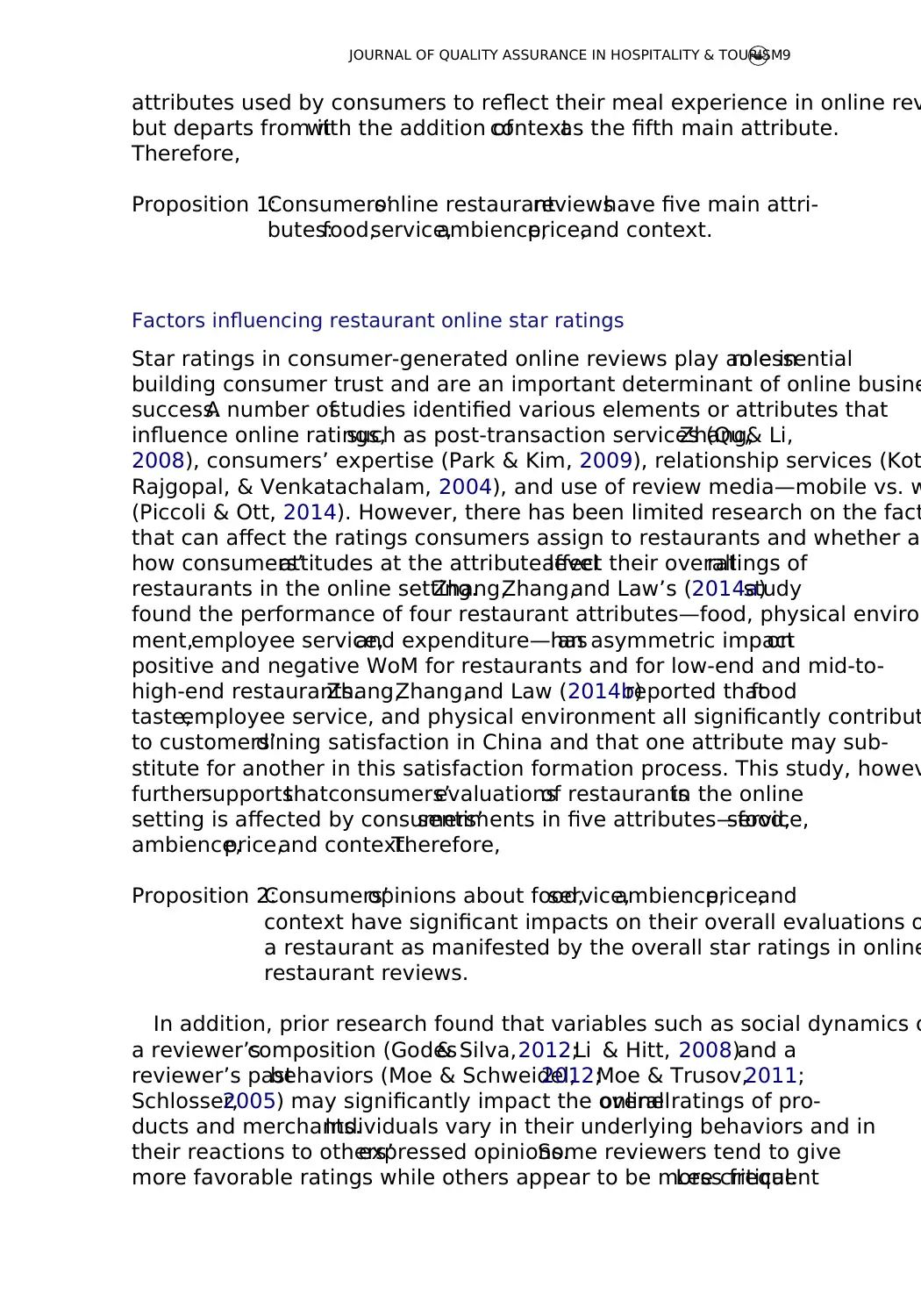
attributes used by consumers to reflect their meal experience in online rev
but departs from itwith the addition ofcontextas the fifth main attribute.
Therefore,
Proposition 1:Consumers’online restaurantreviewshave five main attri-
butes:food,service,ambience,price,and context.
Factors influencing restaurant online star ratings
Star ratings in consumer-generated online reviews play an essentialrole in
building consumer trust and are an important determinant of online busine
success.A number ofstudies identified various elements or attributes that
influence online ratings,such as post-transaction services (Qu,Zhang,& Li,
2008), consumers’ expertise (Park & Kim, 2009), relationship services (Kot
Rajgopal, & Venkatachalam, 2004), and use of review media—mobile vs. w
(Piccoli & Ott, 2014). However, there has been limited research on the fact
that can affect the ratings consumers assign to restaurants and whether an
how consumers’attitudes at the attribute levelaffect their overallratings of
restaurants in the online setting.Zhang,Zhang,and Law’s (2014a)study
found the performance of four restaurant attributes—food, physical environ
ment,employee service,and expenditure—hasan asymmetric impacton
positive and negative WoM for restaurants and for low-end and mid-to-
high-end restaurants.Zhang,Zhang,and Law (2014b)reported thatfood
taste,employee service, and physical environment all significantly contribut
to customers’dining satisfaction in China and that one attribute may sub-
stitute for another in this satisfaction formation process. This study, howev
furthersupportsthatconsumers’evaluationsof restaurantsin the online
setting is affected by consumers’sentiments in five attributes—food,service,
ambience,price,and context.Therefore,
Proposition 2:Consumers’opinions about food,service,ambience,price,and
context have significant impacts on their overall evaluations o
a restaurant as manifested by the overall star ratings in online
restaurant reviews.
In addition, prior research found that variables such as social dynamics o
a reviewer’scomposition (Godes& Silva,2012;Li & Hitt, 2008)and a
reviewer’s pastbehaviors (Moe & Schweidel,2012;Moe & Trusov,2011;
Schlosser,2005) may significantly impact the overallonline ratings of pro-
ducts and merchants.Individuals vary in their underlying behaviors and in
their reactions to others’expressed opinions.Some reviewers tend to give
more favorable ratings while others appear to be more critical.Less frequent
JOURNAL OF QUALITY ASSURANCE IN HOSPITALITY & TOURISM9
but departs from itwith the addition ofcontextas the fifth main attribute.
Therefore,
Proposition 1:Consumers’online restaurantreviewshave five main attri-
butes:food,service,ambience,price,and context.
Factors influencing restaurant online star ratings
Star ratings in consumer-generated online reviews play an essentialrole in
building consumer trust and are an important determinant of online busine
success.A number ofstudies identified various elements or attributes that
influence online ratings,such as post-transaction services (Qu,Zhang,& Li,
2008), consumers’ expertise (Park & Kim, 2009), relationship services (Kot
Rajgopal, & Venkatachalam, 2004), and use of review media—mobile vs. w
(Piccoli & Ott, 2014). However, there has been limited research on the fact
that can affect the ratings consumers assign to restaurants and whether an
how consumers’attitudes at the attribute levelaffect their overallratings of
restaurants in the online setting.Zhang,Zhang,and Law’s (2014a)study
found the performance of four restaurant attributes—food, physical environ
ment,employee service,and expenditure—hasan asymmetric impacton
positive and negative WoM for restaurants and for low-end and mid-to-
high-end restaurants.Zhang,Zhang,and Law (2014b)reported thatfood
taste,employee service, and physical environment all significantly contribut
to customers’dining satisfaction in China and that one attribute may sub-
stitute for another in this satisfaction formation process. This study, howev
furthersupportsthatconsumers’evaluationsof restaurantsin the online
setting is affected by consumers’sentiments in five attributes—food,service,
ambience,price,and context.Therefore,
Proposition 2:Consumers’opinions about food,service,ambience,price,and
context have significant impacts on their overall evaluations o
a restaurant as manifested by the overall star ratings in online
restaurant reviews.
In addition, prior research found that variables such as social dynamics o
a reviewer’scomposition (Godes& Silva,2012;Li & Hitt, 2008)and a
reviewer’s pastbehaviors (Moe & Schweidel,2012;Moe & Trusov,2011;
Schlosser,2005) may significantly impact the overallonline ratings of pro-
ducts and merchants.Individuals vary in their underlying behaviors and in
their reactions to others’expressed opinions.Some reviewers tend to give
more favorable ratings while others appear to be more critical.Less frequent
JOURNAL OF QUALITY ASSURANCE IN HOSPITALITY & TOURISM9
Paraphrase This Document
Need a fresh take? Get an instant paraphrase of this document with our AI Paraphraser
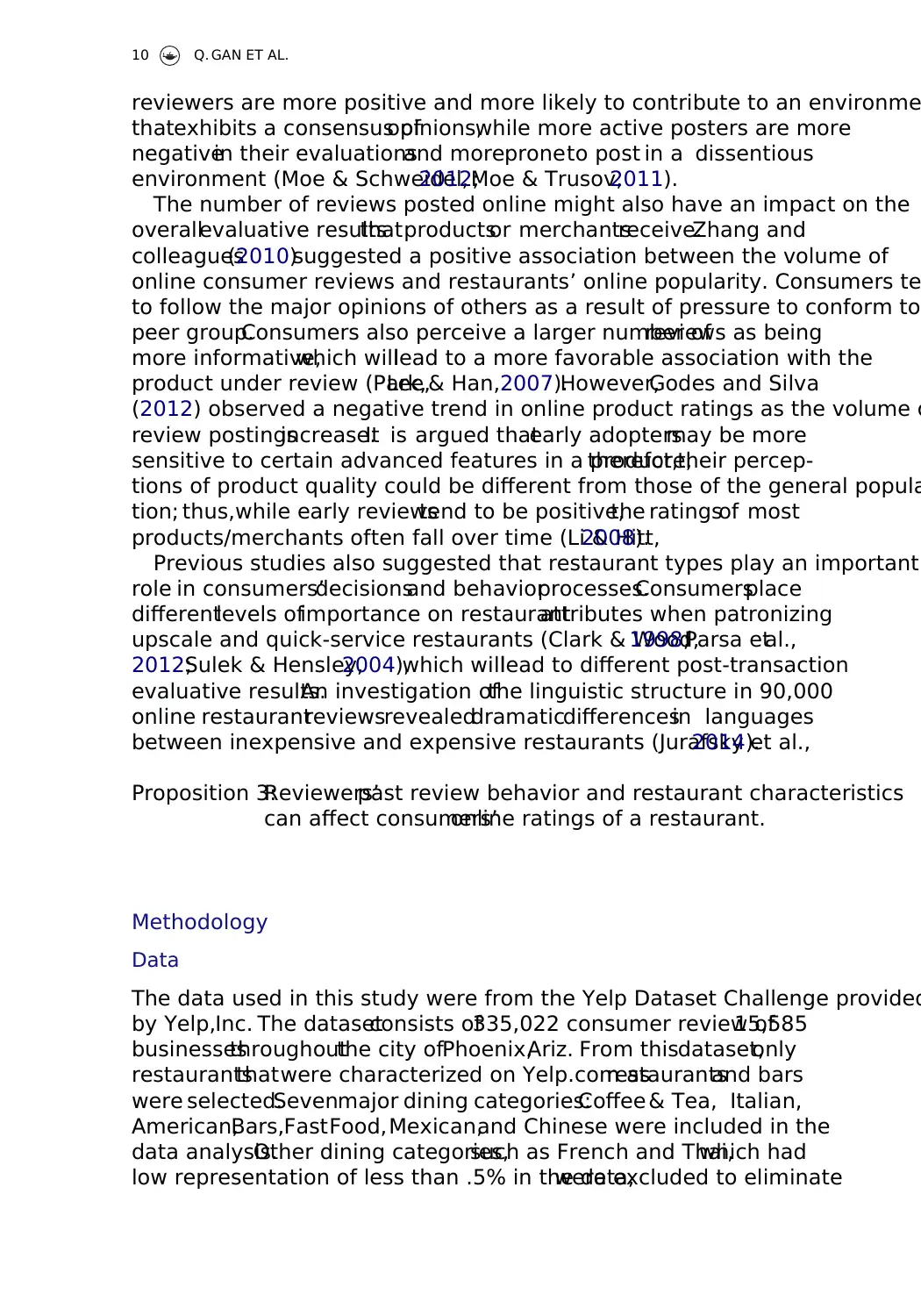
reviewers are more positive and more likely to contribute to an environme
thatexhibits a consensus ofopinions,while more active posters are more
negativein their evaluationsand moreproneto post in a dissentious
environment (Moe & Schweidel,2012;Moe & Trusov,2011).
The number of reviews posted online might also have an impact on the
overallevaluative resultsthatproductsor merchantsreceive.Zhang and
colleagues(2010)suggested a positive association between the volume of
online consumer reviews and restaurants’ online popularity. Consumers te
to follow the major opinions of others as a result of pressure to conform to
peer group.Consumers also perceive a larger number ofreviews as being
more informative,which willlead to a more favorable association with the
product under review (Park,Lee,& Han,2007).However,Godes and Silva
(2012) observed a negative trend in online product ratings as the volume o
review postingsincrease.It is argued thatearly adoptersmay be more
sensitive to certain advanced features in a product,therefore,their percep-
tions of product quality could be different from those of the general popula
tion; thus,while early reviewstend to be positive,the ratingsof most
products/merchants often fall over time (Li & Hitt,2008).
Previous studies also suggested that restaurant types play an important
role in consumers’decisionsand behaviorprocesses.Consumersplace
differentlevels ofimportance on restaurantattributes when patronizing
upscale and quick-service restaurants (Clark & Wood,1998;Parsa etal.,
2012;Sulek & Hensley,2004),which willlead to different post-transaction
evaluative results.An investigation ofthe linguistic structure in 90,000
online restaurantreviewsrevealeddramaticdifferencesin languages
between inexpensive and expensive restaurants (Jurafsky et al.,2014).
Proposition 3:Reviewers’past review behavior and restaurant characteristics
can affect consumers’online ratings of a restaurant.
Methodology
Data
The data used in this study were from the Yelp Dataset Challenge provided
by Yelp,Inc. The datasetconsists of335,022 consumer review of15,585
businessesthroughoutthe city ofPhoenix,Ariz. From thisdataset,only
restaurantsthatwere characterized on Yelp.com asrestaurantsand bars
were selected.Sevenmajor dining categories:Coffee & Tea, Italian,
American,Bars,FastFood,Mexican,and Chinese were included in the
data analysis.Other dining categories,such as French and Thai,which had
low representation of less than .5% in the data,were excluded to eliminate
10 Q. GAN ET AL.
thatexhibits a consensus ofopinions,while more active posters are more
negativein their evaluationsand moreproneto post in a dissentious
environment (Moe & Schweidel,2012;Moe & Trusov,2011).
The number of reviews posted online might also have an impact on the
overallevaluative resultsthatproductsor merchantsreceive.Zhang and
colleagues(2010)suggested a positive association between the volume of
online consumer reviews and restaurants’ online popularity. Consumers te
to follow the major opinions of others as a result of pressure to conform to
peer group.Consumers also perceive a larger number ofreviews as being
more informative,which willlead to a more favorable association with the
product under review (Park,Lee,& Han,2007).However,Godes and Silva
(2012) observed a negative trend in online product ratings as the volume o
review postingsincrease.It is argued thatearly adoptersmay be more
sensitive to certain advanced features in a product,therefore,their percep-
tions of product quality could be different from those of the general popula
tion; thus,while early reviewstend to be positive,the ratingsof most
products/merchants often fall over time (Li & Hitt,2008).
Previous studies also suggested that restaurant types play an important
role in consumers’decisionsand behaviorprocesses.Consumersplace
differentlevels ofimportance on restaurantattributes when patronizing
upscale and quick-service restaurants (Clark & Wood,1998;Parsa etal.,
2012;Sulek & Hensley,2004),which willlead to different post-transaction
evaluative results.An investigation ofthe linguistic structure in 90,000
online restaurantreviewsrevealeddramaticdifferencesin languages
between inexpensive and expensive restaurants (Jurafsky et al.,2014).
Proposition 3:Reviewers’past review behavior and restaurant characteristics
can affect consumers’online ratings of a restaurant.
Methodology
Data
The data used in this study were from the Yelp Dataset Challenge provided
by Yelp,Inc. The datasetconsists of335,022 consumer review of15,585
businessesthroughoutthe city ofPhoenix,Ariz. From thisdataset,only
restaurantsthatwere characterized on Yelp.com asrestaurantsand bars
were selected.Sevenmajor dining categories:Coffee & Tea, Italian,
American,Bars,FastFood,Mexican,and Chinese were included in the
data analysis.Other dining categories,such as French and Thai,which had
low representation of less than .5% in the data,were excluded to eliminate
10 Q. GAN ET AL.
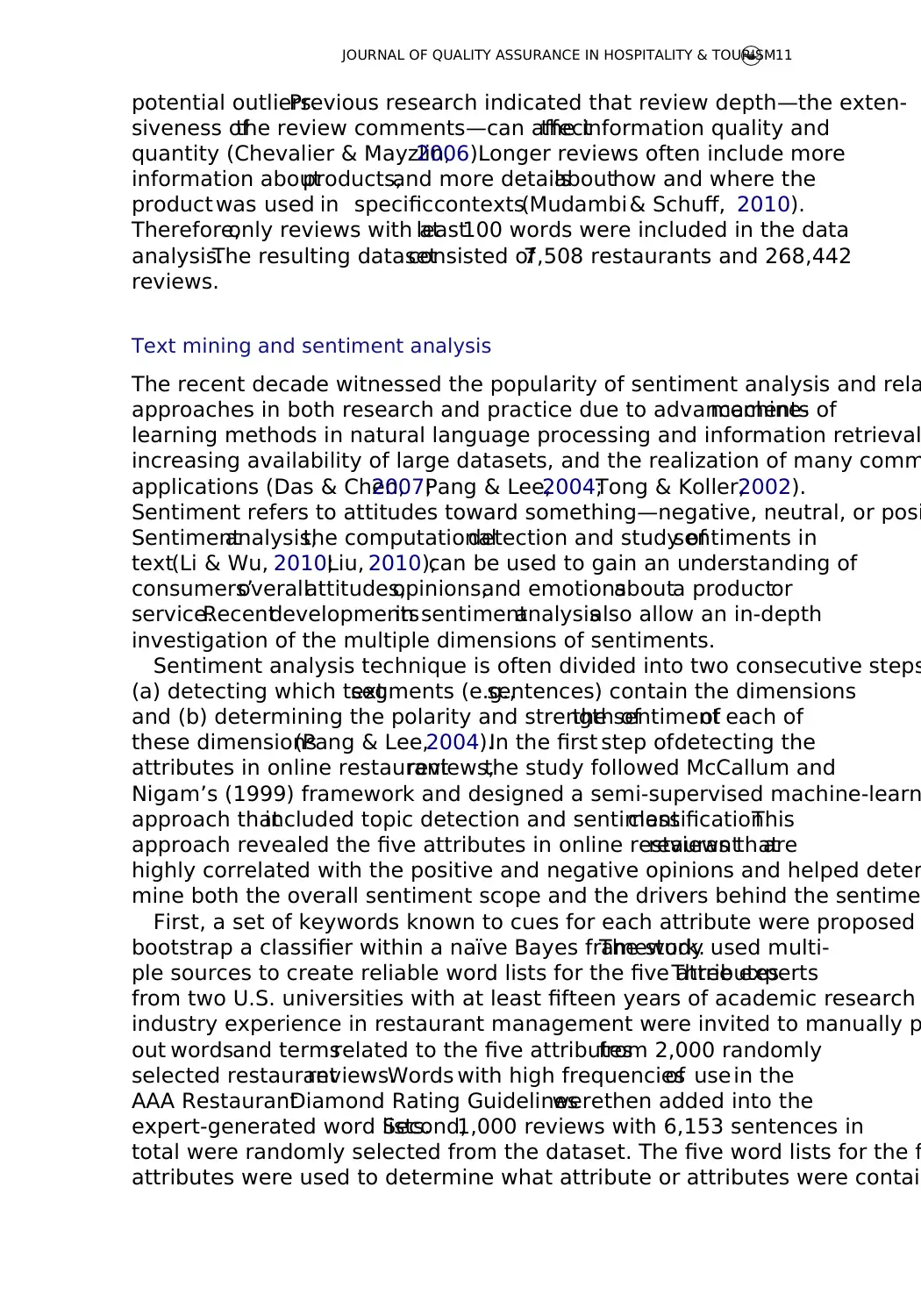
potential outliers.Previous research indicated that review depth—the exten-
siveness ofthe review comments—can affectthe information quality and
quantity (Chevalier & Mayzlin,2006).Longer reviews often include more
information aboutproducts,and more detailsabouthow and where the
product was used in specificcontexts(Mudambi & Schuff, 2010).
Therefore,only reviews with atleast100 words were included in the data
analysis.The resulting datasetconsisted of7,508 restaurants and 268,442
reviews.
Text mining and sentiment analysis
The recent decade witnessed the popularity of sentiment analysis and rela
approaches in both research and practice due to advancements ofmachine-
learning methods in natural language processing and information retrieval
increasing availability of large datasets, and the realization of many comm
applications (Das & Chen,2007;Pang & Lee,2004;Tong & Koller,2002).
Sentiment refers to attitudes toward something—negative, neutral, or posi
Sentimentanalysis,the computationaldetection and study ofsentiments in
text(Li & Wu, 2010;Liu, 2010),can be used to gain an understanding of
consumers’overallattitudes,opinions,and emotionsabouta productor
service.Recentdevelopmentsin sentimentanalysisalso allow an in-depth
investigation of the multiple dimensions of sentiments.
Sentiment analysis technique is often divided into two consecutive steps
(a) detecting which textsegments (e.g.,sentences) contain the dimensions
and (b) determining the polarity and strength ofthe sentimentof each of
these dimensions(Pang & Lee,2004).In the first step ofdetecting the
attributes in online restaurantreviews,the study followed McCallum and
Nigam’s (1999) framework and designed a semi-supervised machine-learn
approach thatincluded topic detection and sentimentclassification.This
approach revealed the five attributes in online restaurantreviews thatare
highly correlated with the positive and negative opinions and helped deter
mine both the overall sentiment scope and the drivers behind the sentimen
First, a set of keywords known to cues for each attribute were proposed
bootstrap a classifier within a naïve Bayes framework.The study used multi-
ple sources to create reliable word lists for the five attributes.Three experts
from two U.S. universities with at least fifteen years of academic research
industry experience in restaurant management were invited to manually p
out wordsand termsrelated to the five attributesfrom 2,000 randomly
selected restaurantreviews.Words with high frequenciesof use in the
AAA RestaurantDiamond Rating Guidelineswerethen added into the
expert-generated word lists.Second,1,000 reviews with 6,153 sentences in
total were randomly selected from the dataset. The five word lists for the fi
attributes were used to determine what attribute or attributes were contain
JOURNAL OF QUALITY ASSURANCE IN HOSPITALITY & TOURISM11
siveness ofthe review comments—can affectthe information quality and
quantity (Chevalier & Mayzlin,2006).Longer reviews often include more
information aboutproducts,and more detailsabouthow and where the
product was used in specificcontexts(Mudambi & Schuff, 2010).
Therefore,only reviews with atleast100 words were included in the data
analysis.The resulting datasetconsisted of7,508 restaurants and 268,442
reviews.
Text mining and sentiment analysis
The recent decade witnessed the popularity of sentiment analysis and rela
approaches in both research and practice due to advancements ofmachine-
learning methods in natural language processing and information retrieval
increasing availability of large datasets, and the realization of many comm
applications (Das & Chen,2007;Pang & Lee,2004;Tong & Koller,2002).
Sentiment refers to attitudes toward something—negative, neutral, or posi
Sentimentanalysis,the computationaldetection and study ofsentiments in
text(Li & Wu, 2010;Liu, 2010),can be used to gain an understanding of
consumers’overallattitudes,opinions,and emotionsabouta productor
service.Recentdevelopmentsin sentimentanalysisalso allow an in-depth
investigation of the multiple dimensions of sentiments.
Sentiment analysis technique is often divided into two consecutive steps
(a) detecting which textsegments (e.g.,sentences) contain the dimensions
and (b) determining the polarity and strength ofthe sentimentof each of
these dimensions(Pang & Lee,2004).In the first step ofdetecting the
attributes in online restaurantreviews,the study followed McCallum and
Nigam’s (1999) framework and designed a semi-supervised machine-learn
approach thatincluded topic detection and sentimentclassification.This
approach revealed the five attributes in online restaurantreviews thatare
highly correlated with the positive and negative opinions and helped deter
mine both the overall sentiment scope and the drivers behind the sentimen
First, a set of keywords known to cues for each attribute were proposed
bootstrap a classifier within a naïve Bayes framework.The study used multi-
ple sources to create reliable word lists for the five attributes.Three experts
from two U.S. universities with at least fifteen years of academic research
industry experience in restaurant management were invited to manually p
out wordsand termsrelated to the five attributesfrom 2,000 randomly
selected restaurantreviews.Words with high frequenciesof use in the
AAA RestaurantDiamond Rating Guidelineswerethen added into the
expert-generated word lists.Second,1,000 reviews with 6,153 sentences in
total were randomly selected from the dataset. The five word lists for the fi
attributes were used to determine what attribute or attributes were contain
JOURNAL OF QUALITY ASSURANCE IN HOSPITALITY & TOURISM11
⊘ This is a preview!⊘
Do you want full access?
Subscribe today to unlock all pages.

Trusted by 1+ million students worldwide
1 out of 29
Your All-in-One AI-Powered Toolkit for Academic Success.
+13062052269
info@desklib.com
Available 24*7 on WhatsApp / Email
![[object Object]](/_next/static/media/star-bottom.7253800d.svg)
Unlock your academic potential
Copyright © 2020–2025 A2Z Services. All Rights Reserved. Developed and managed by ZUCOL.
